This post may contain affiliate links. Please read our disclosure policy.
Learning how to make mustard is a lot easier than you’d think. In fact, this homemade mustard recipe is super simple and takes just under an hour to whip up a batch.
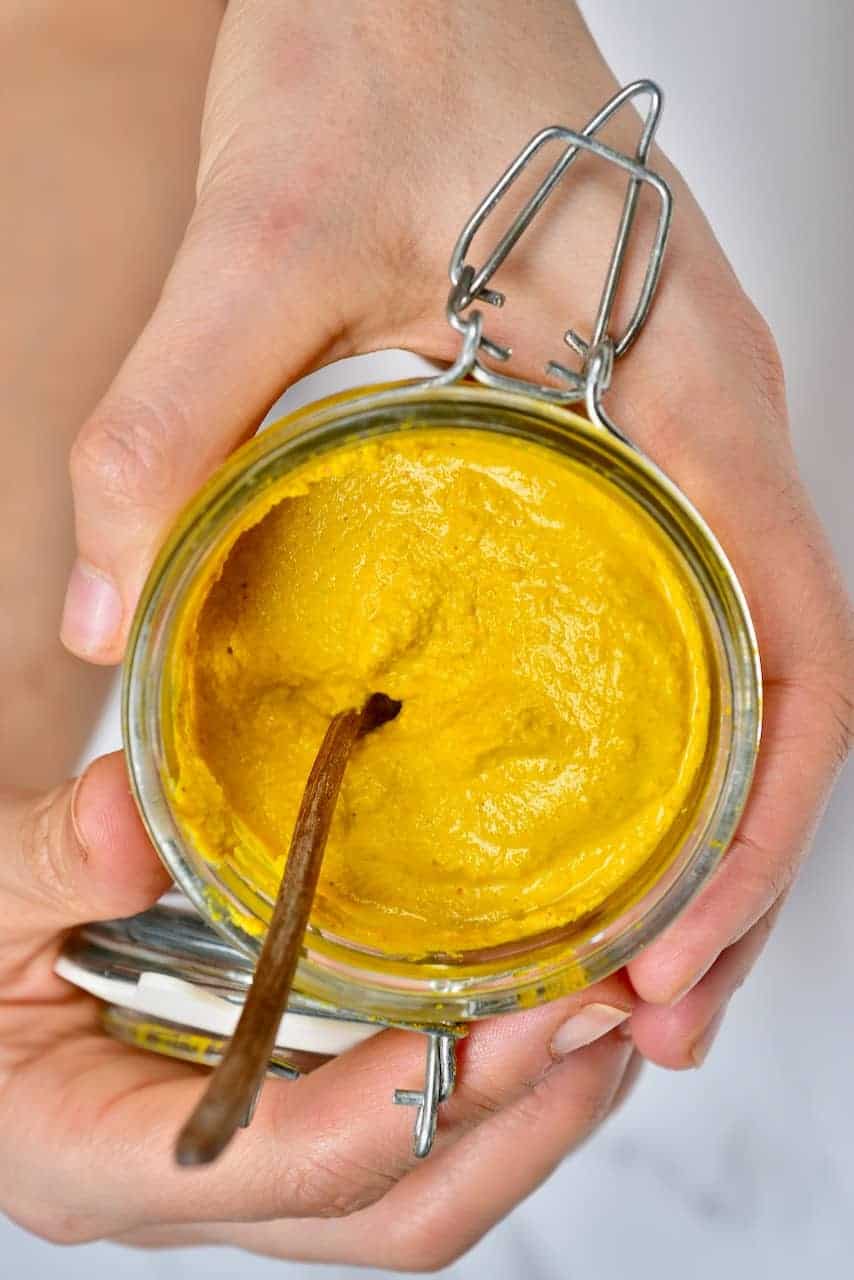
Recently I posted my homemade recipes for simple homemade ketchup and mayonnaise, so this mustard recipe was inevitable. This smooth homemade mustard recipe is a wonderful DIY option for all condiment lovers out there wanting to learn how to make mustard easily at home.
I have to admit that this recipe does take longer than lots of mustard recipes as I prepare it with heat rather than pre-soaking the seeds and blending. Other varieties may use cold liquids only, but after trying various methods, this is my favorite. The heat method allows the homemade mustard to be more mellow in flavor, while still having that classic mustard “zing”.
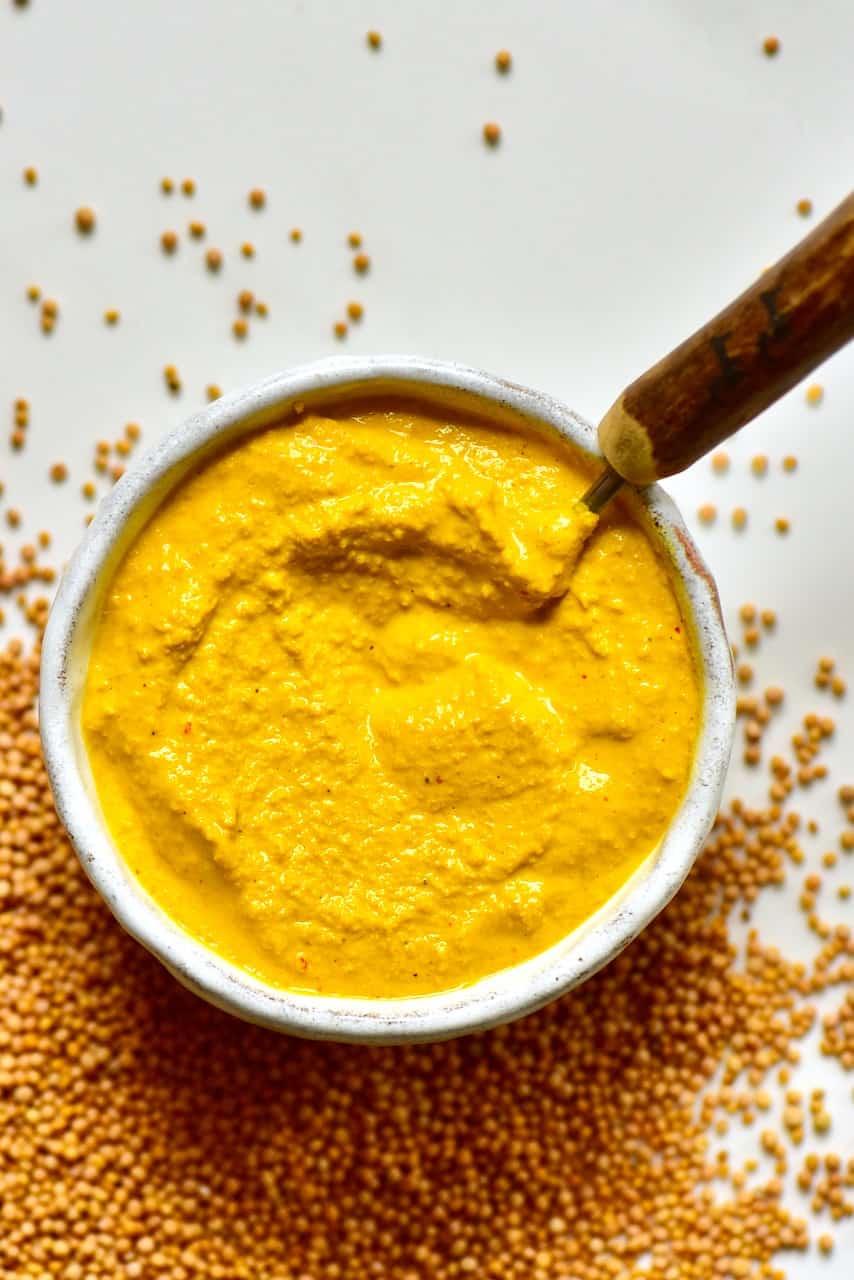
You can then use it anywhere you usually would – as a condiment for a variety of dishes, a spoonful or two in sauces, for salad dressings, etc.
Want to save this recipe?
The Different Types Of Mustard
I have to admit that I’m not that adventurous with my mustard consumption. I’ve used a few main varieties, and that is all – with my most favorite being simple yellow mustard. But here’s a shortlist of the top few and their “features”.
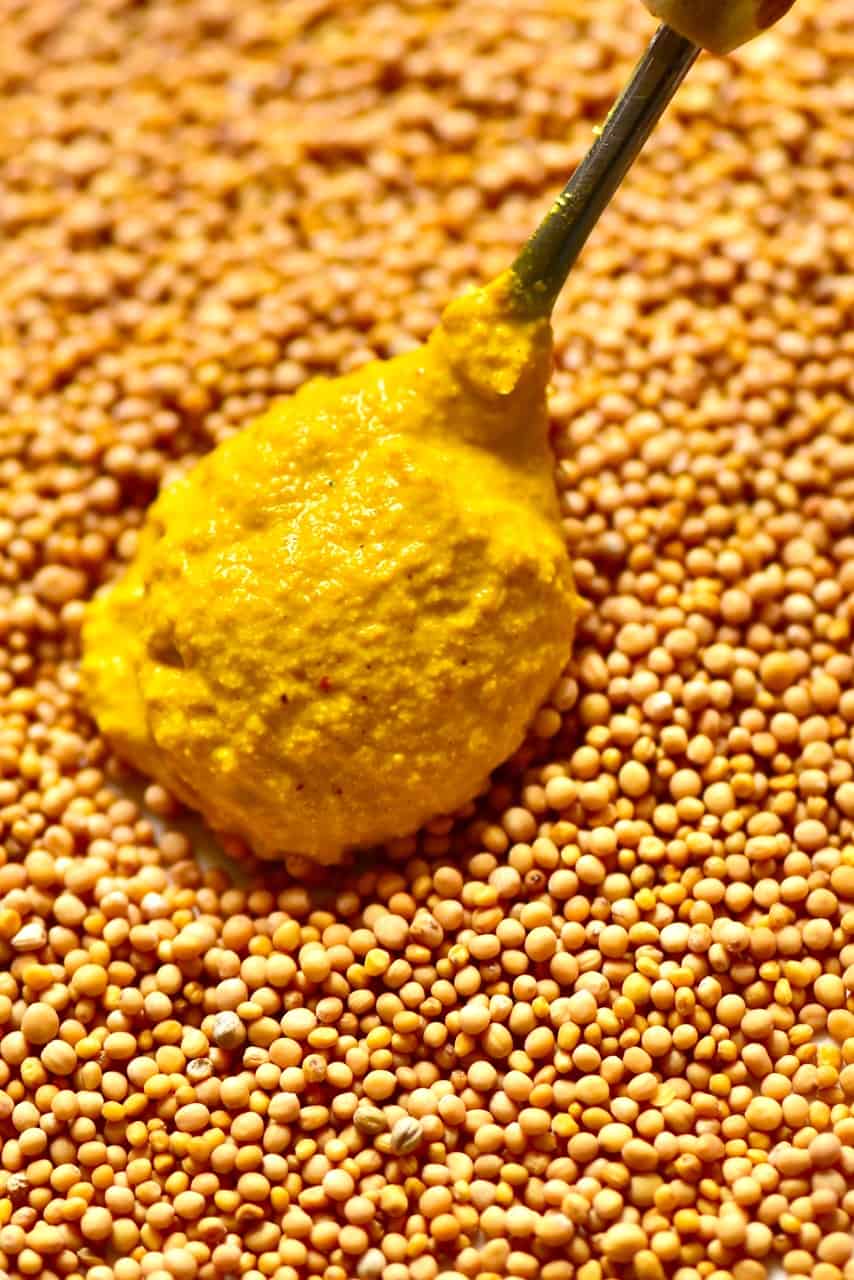
Powdered Mustard: This is powdered dry mustard seeds and the base to the majority of other mustard recipes. However, it’s also good to be used as part of a spice mix or rub or even stirred into sauces, to add that little pow. I use it for my homemade mayonnaise too.
Whole Grain Mustard: This is precisely what it sounds like. Rather than using powdered seeds in the mustard recipe, whole grain mustard uses whole seeds combined with a few other ingredients and has a caviar-like appearance.
Dijon Mustard: Dijon mustard is made in a slightly different way to your “standard yellow” mustard with the use of white wine and the darker brown and/or black mustard seeds. Its color is less of a bright yellow and more brown-ish tinted. The taste is also stronger than other mustards and can be quite pungent.
Yellow Mustard: This is what can be considered a “general mustard” and is the most common type used for burgers, hotdogs, etc. Its taste is milder than the dijon variety, which is probably why it’s the more commonly used.
Honey Mustard: How to make honey mustard is super simple. It’s standard mustard mixed with honey at a ratio of 1:1 (usually), for a sweeter, less intense flavor. This can then be used to make a homemade honey mustard sauce and a variety of honey mustard recipes.
The version that I make is closest to a yellow mustard recipe, although the flavor is still fairly sharp – but I like it this way. You can easily add more honey to swap the recipe into a honey mustard DIY.
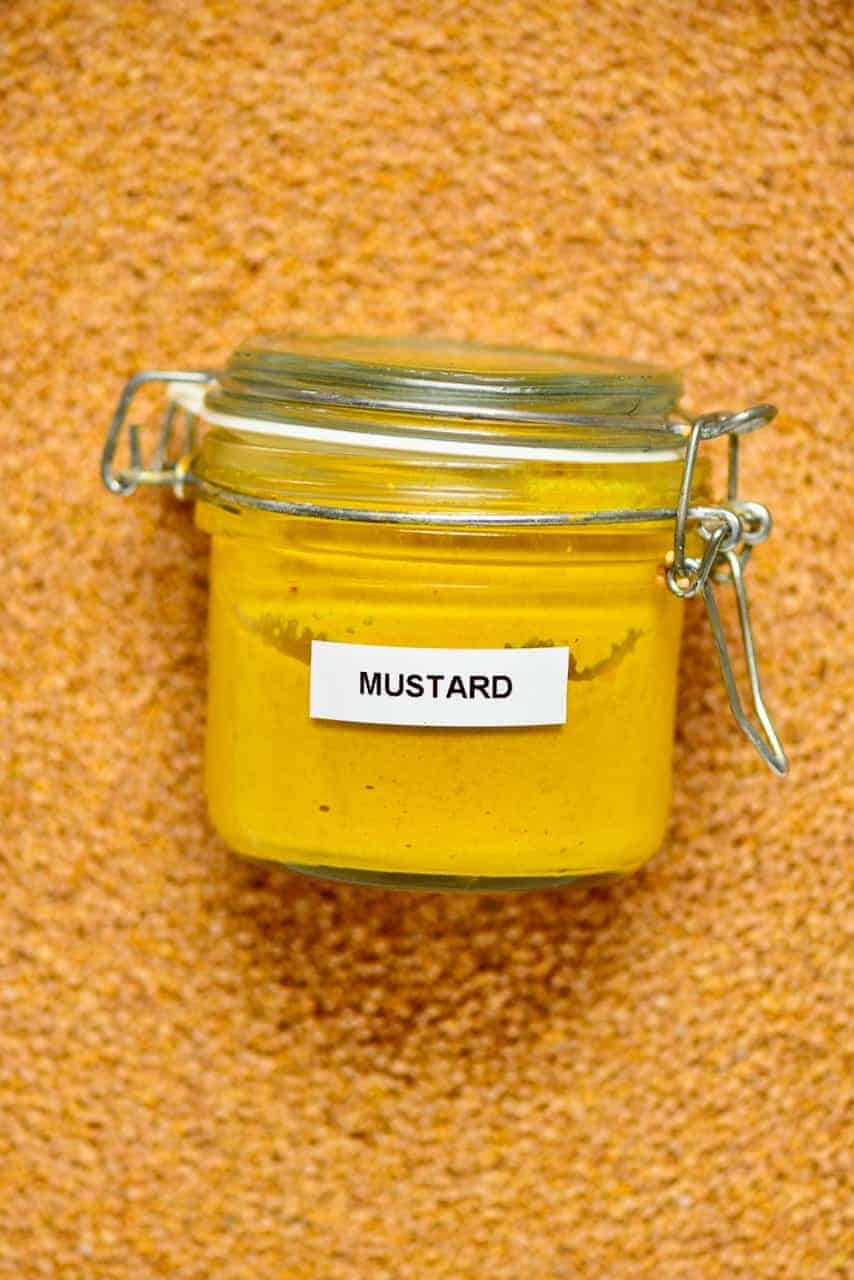
A Few Tips On How To Make Mustard
At its core, mustard is a very simple condiment with a simple recipe. In fact, English Mustard like “Colman’s” is pretty much just the seed powder, water, sugar/salt, turmeric (for color) and a couple of additional ingredients to thicken and preserve.
However, there’s more to it than meets the eye- and why it tastes the way it does. For example, did you know that the punch of ‘zingy’ flavor comes from a chemical inside the seeds reacting to a cold liquid?
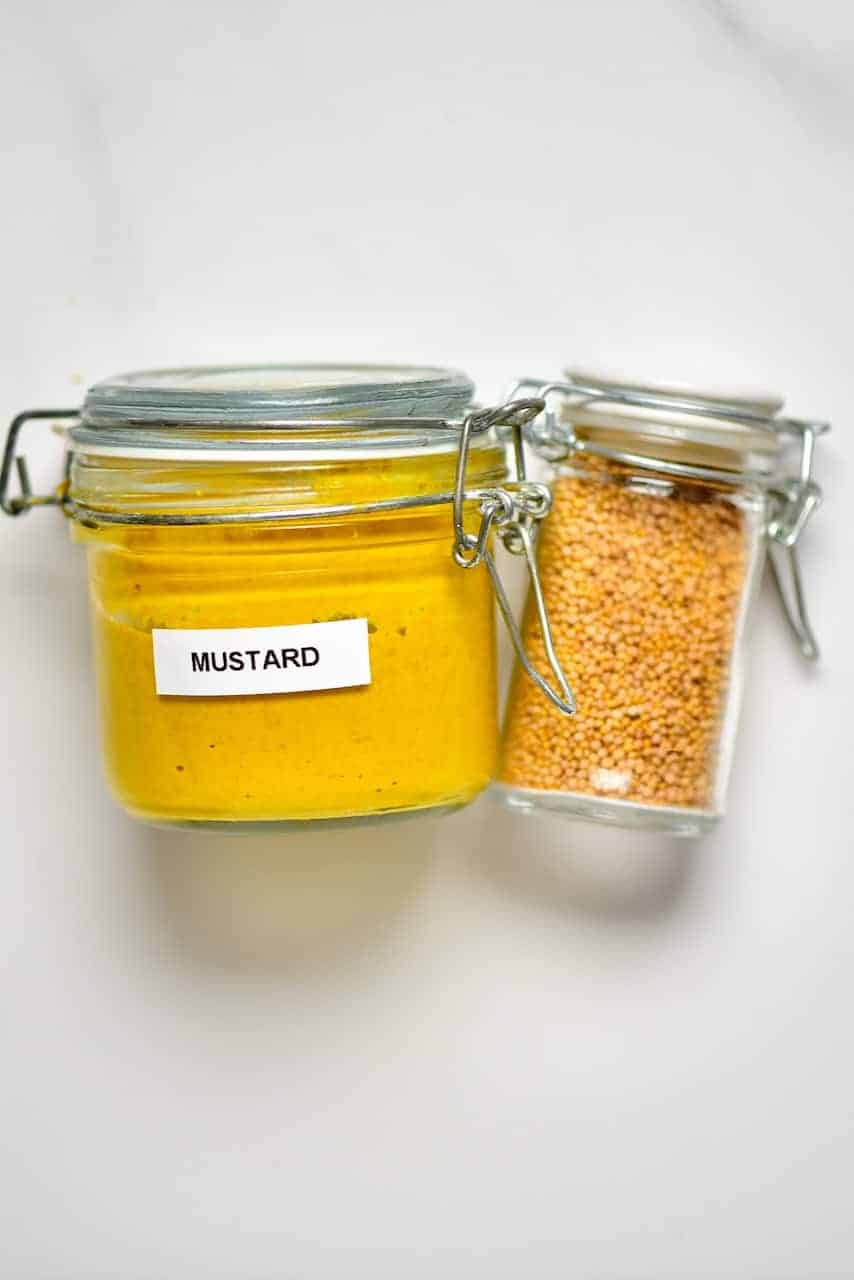
- With this recipe, I do a long slow cook, as I’m preparing milder mustard. However, for a ‘hot’ (as in spicy) version then it’s best to use cold liquids. Whereas, for a milder, mellow yellow mustard, then you can use warmer liquids.
- As a general rule, lighter seeds mean a milder taste and darker seeds mean a hotter, more bitter flavour.
- As this mustard recipe uses ground seeds, it goes without saying that the amount of time spent grinding the seeds will affect the texture of your mustard recipe. If you want a thicker texture, then leave the seeds slightly coarser, for super-smooth, then blend them into as fine of a powder as you can manage.
- Vinegar is used in the recipe to preserve the mustards “zing” – without this acid, it would mellow and lose it’s tang quickly.
- It’s important to note that your homemade mustard will be at it’s most bitter for the first 24 hours after making it. However, the bitterness will fade over time. It’s good to store it in the refrigerator for a day or so while waiting for it to mellow slightly.
- Adding salt to the recipe is what helps preserve the mustard (along with the vinegar). My jar is usually finished within about a month and a half, but I think this would be fine to store for three months, in an airtight container in the fridge– If not, even longer.
- To turn this recipe into homemade honey mustard, then you need to add more honey. Lots of recipes call for a 1:1 ratio of honey to mustard. However, I think you can use less than this, to begin with. In fact, you can make it in a smaller batch by preparing this mustard DIY and then when you want the sweeter version, mix in a tablespoon of honey at a time until you reach your desired sweetness.
What’s needed for this mustard DIY
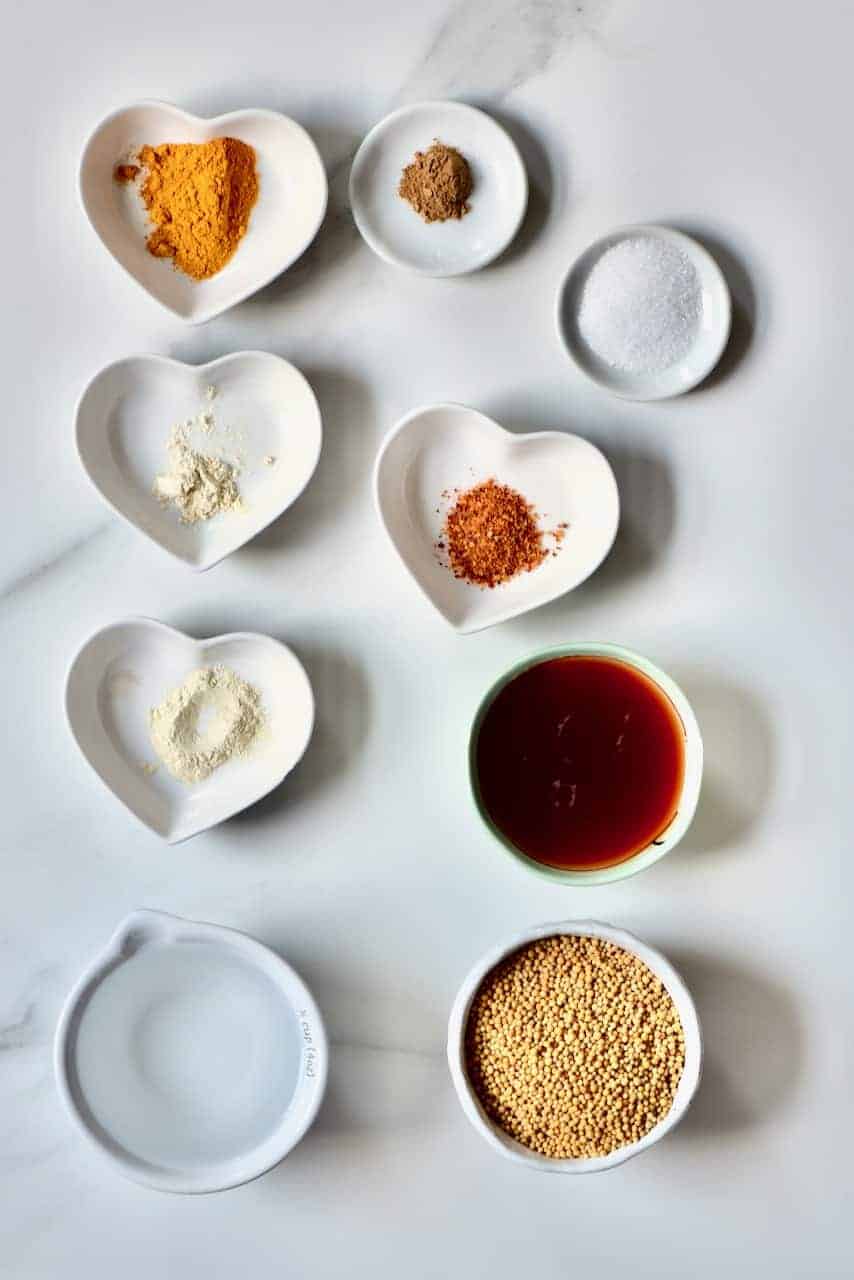
- yellow mustard seeds
- filtered water
- apple cider vinegar or distilled wine vinegar
- turmeric powder – it gives it the yellowish colour like in store-bought versions
- red paprika – this adds extra colour and spice
- honey or maple
- garlic and onion powder
- salt and cinnamon
Other additive options: ginger, clove, horseradish, cinnamon
How to make mustard
Begin by sterilizing all of your tools in boiling water and try to avoid using aluminium (aluminum) or copper utensils/pots during this mustard DIY, as it can affect the taste of your final product. Stick to glass, ceramic, and wood.
Powder the seeds in a spice grinder or a food processor (if it has a small jar). You could also use a mortar and pestle, but it will take a while, and a bit of an arm workout, to achieve the powdery consistency you like.
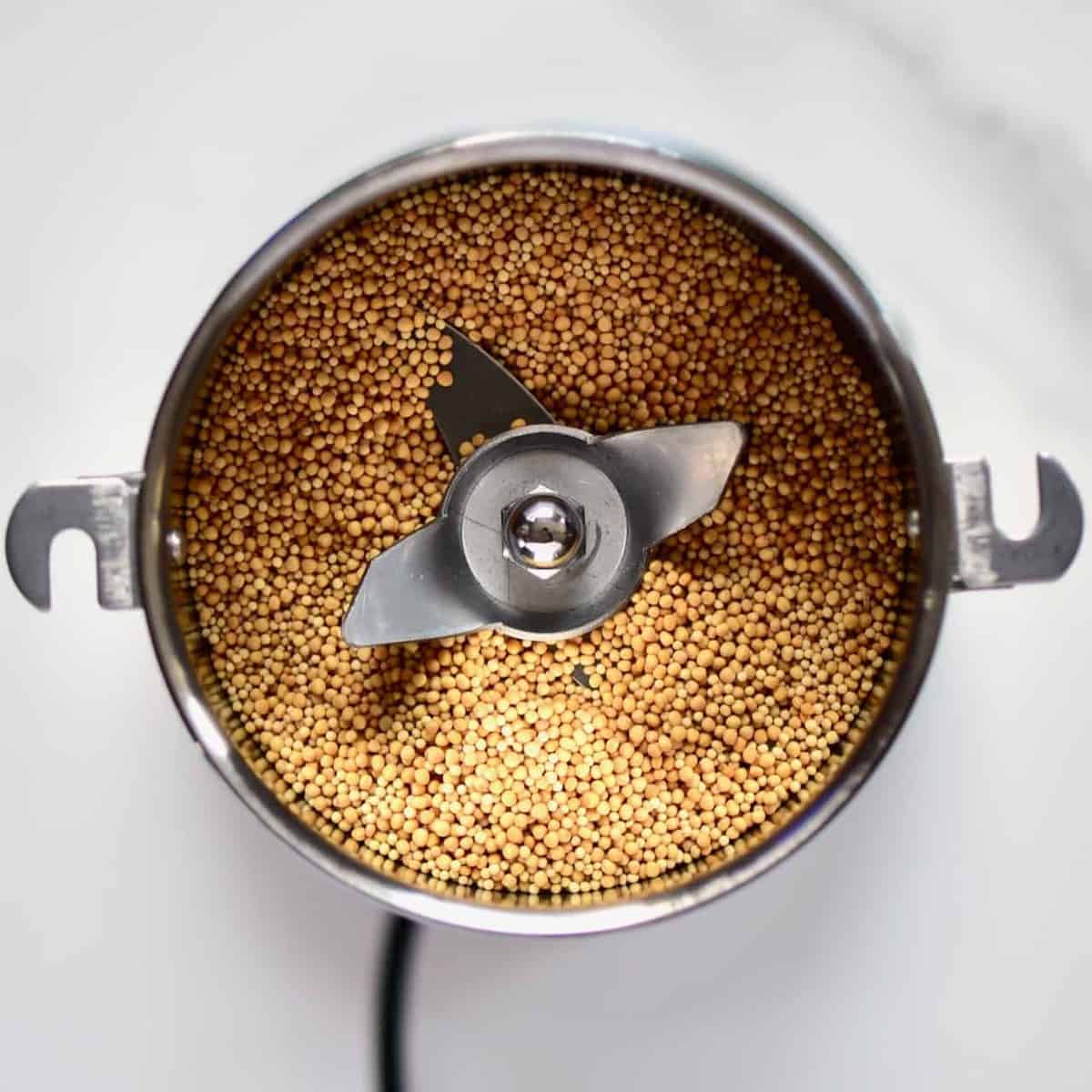
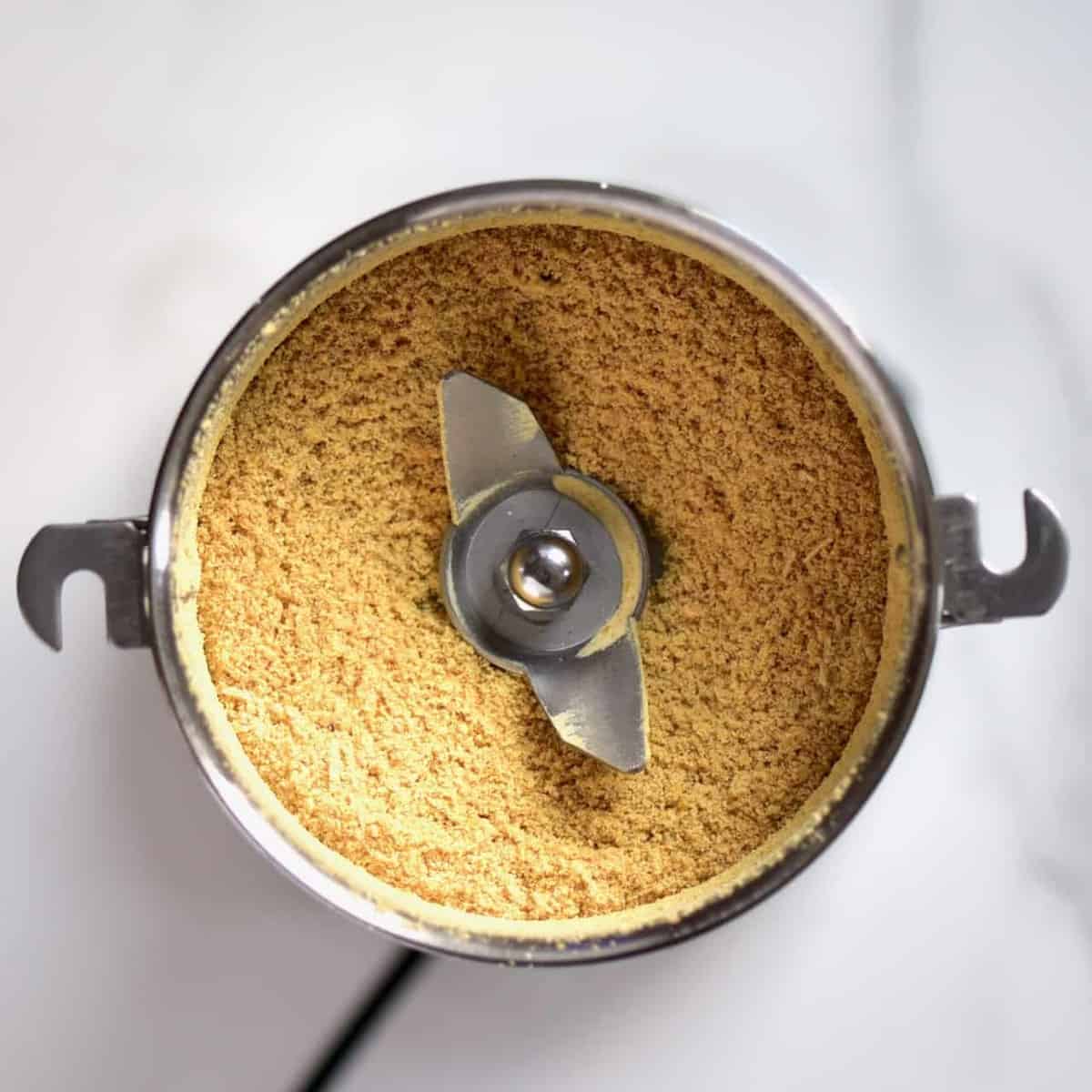
The finer the powder, the smoother the mustard will be. If you prefer it a little more chunky, then don’t blend to a fine powder.
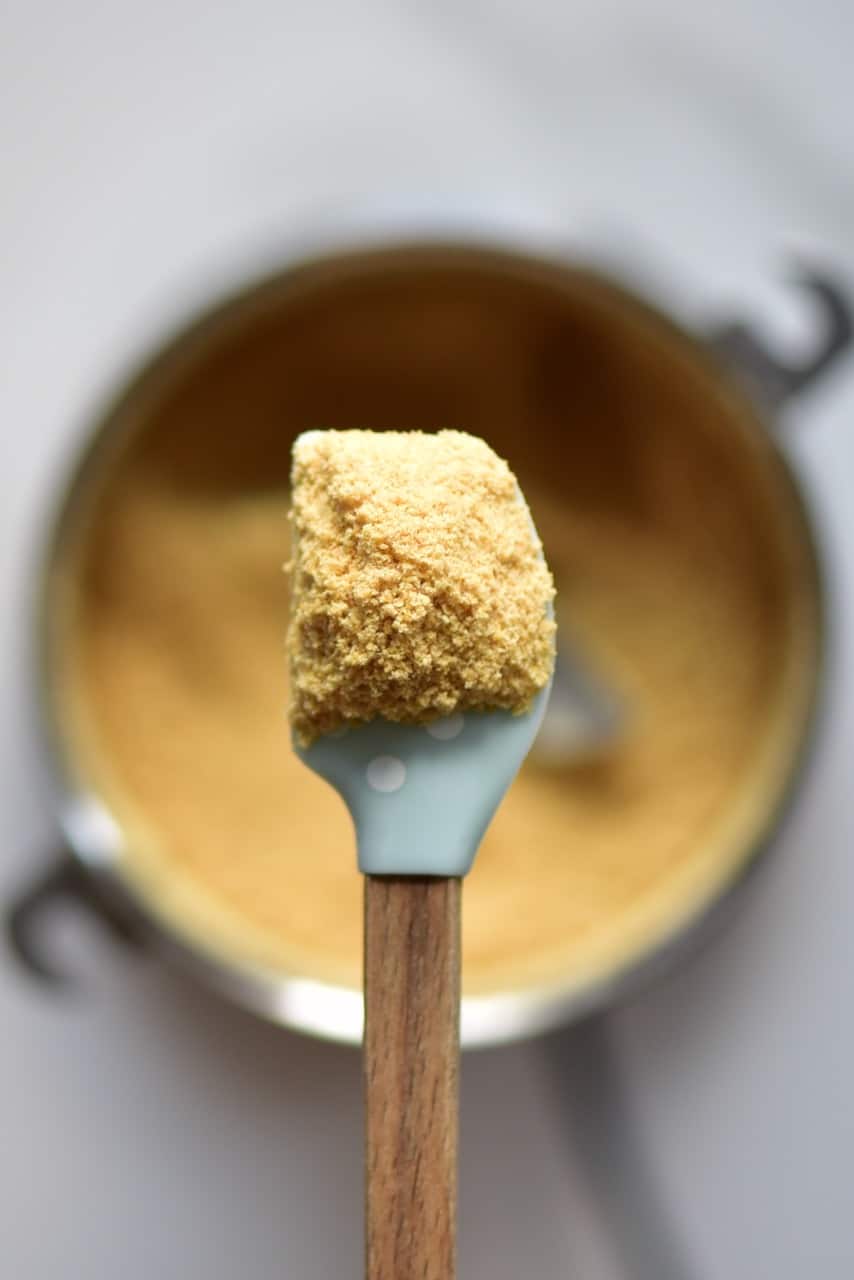
Mix the mustard powder with the rest of the spices.
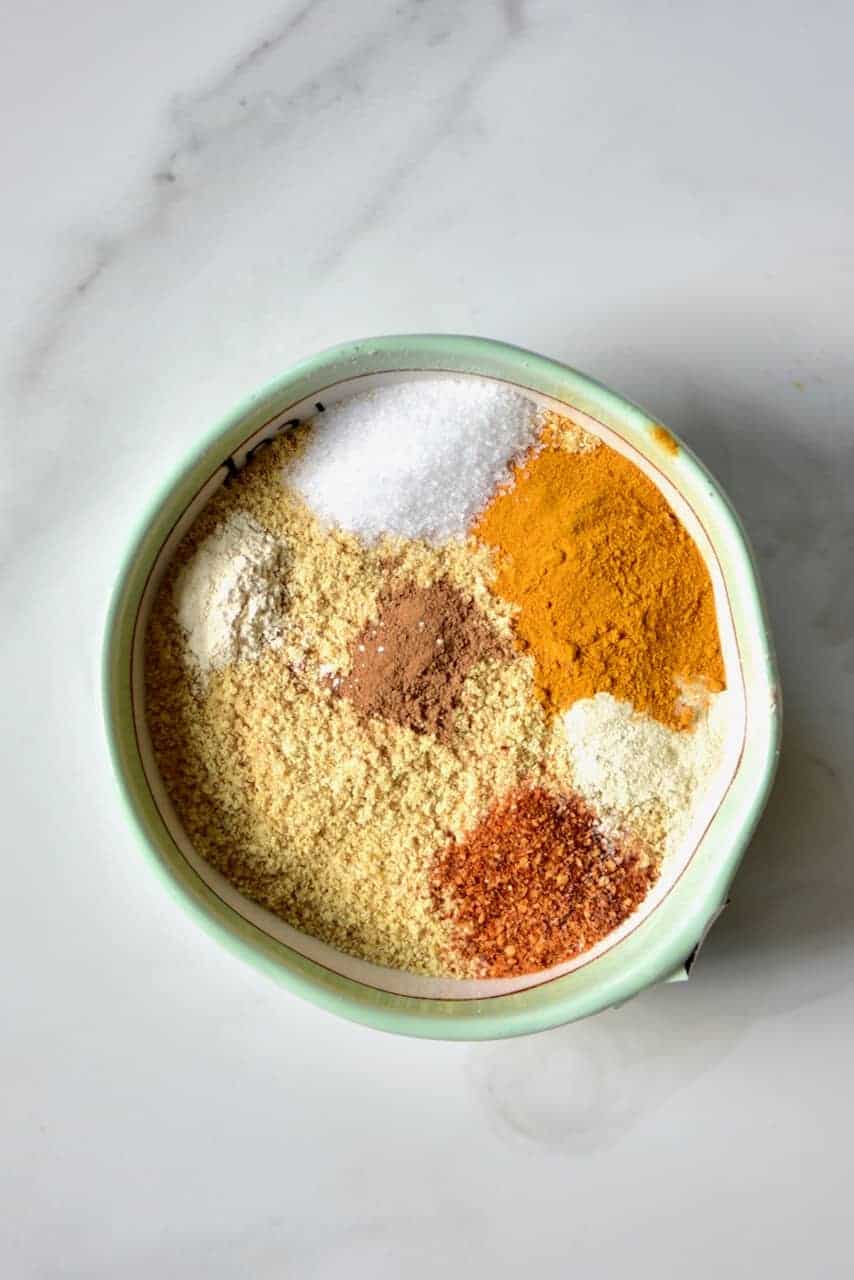
In a saucepan, add the water and the spice mix. Keep the vinegar aside for now.
Cook over low heat for about 45 minutes, until it starts bubbling.
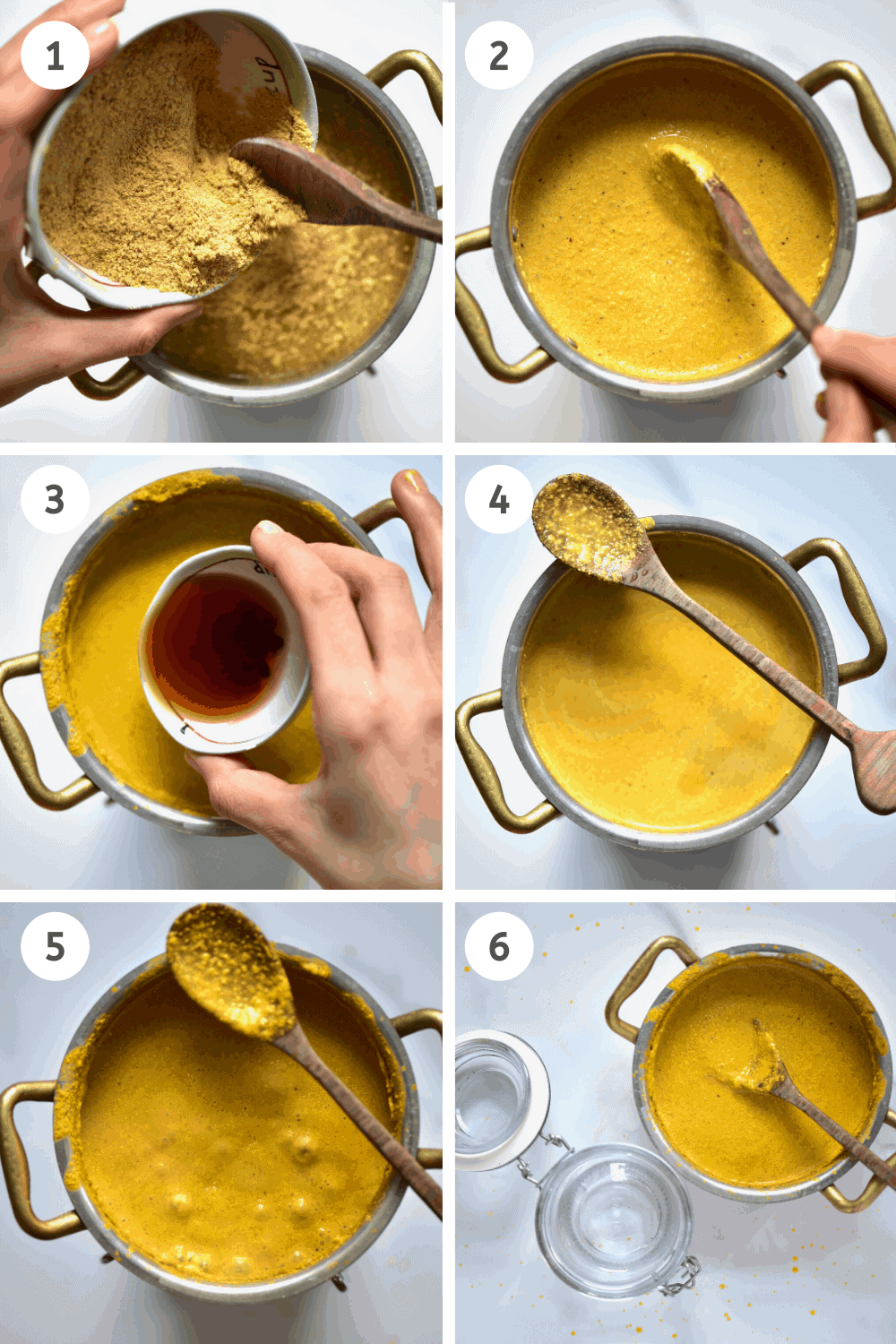
Add the vinegar and let it bubble for another 5-10 minutes. Stir occasionally as it can stick to the bottom of the pan slightly.
Pour in a glass container and leave to cool down completely before transferring to the refrigerator.
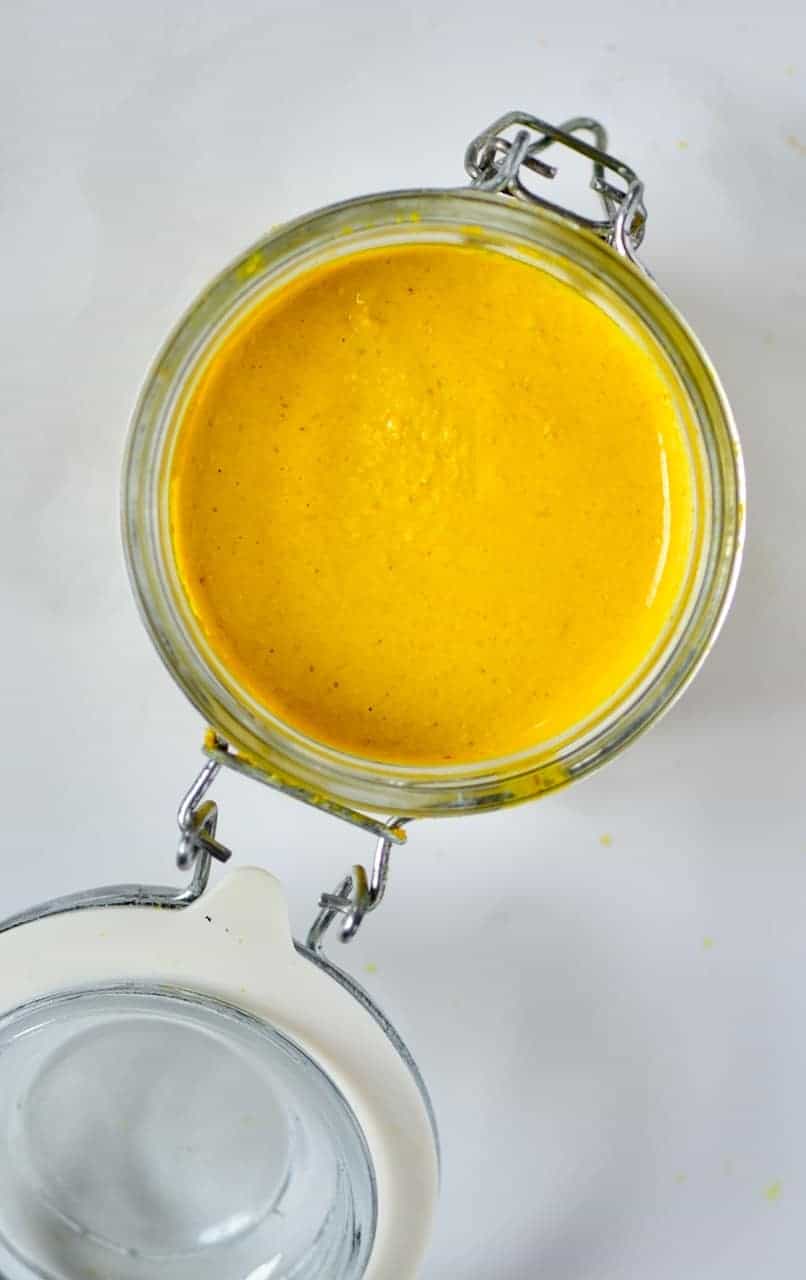
Store in an airtight jar and leave alone for at least 24 hours in the fridge. Mustard is at its most bitter when it has just been made and requires 24 hours (at least) to mellow out, sometimes slightly longer.
Store this in the refrigerator for around three months.
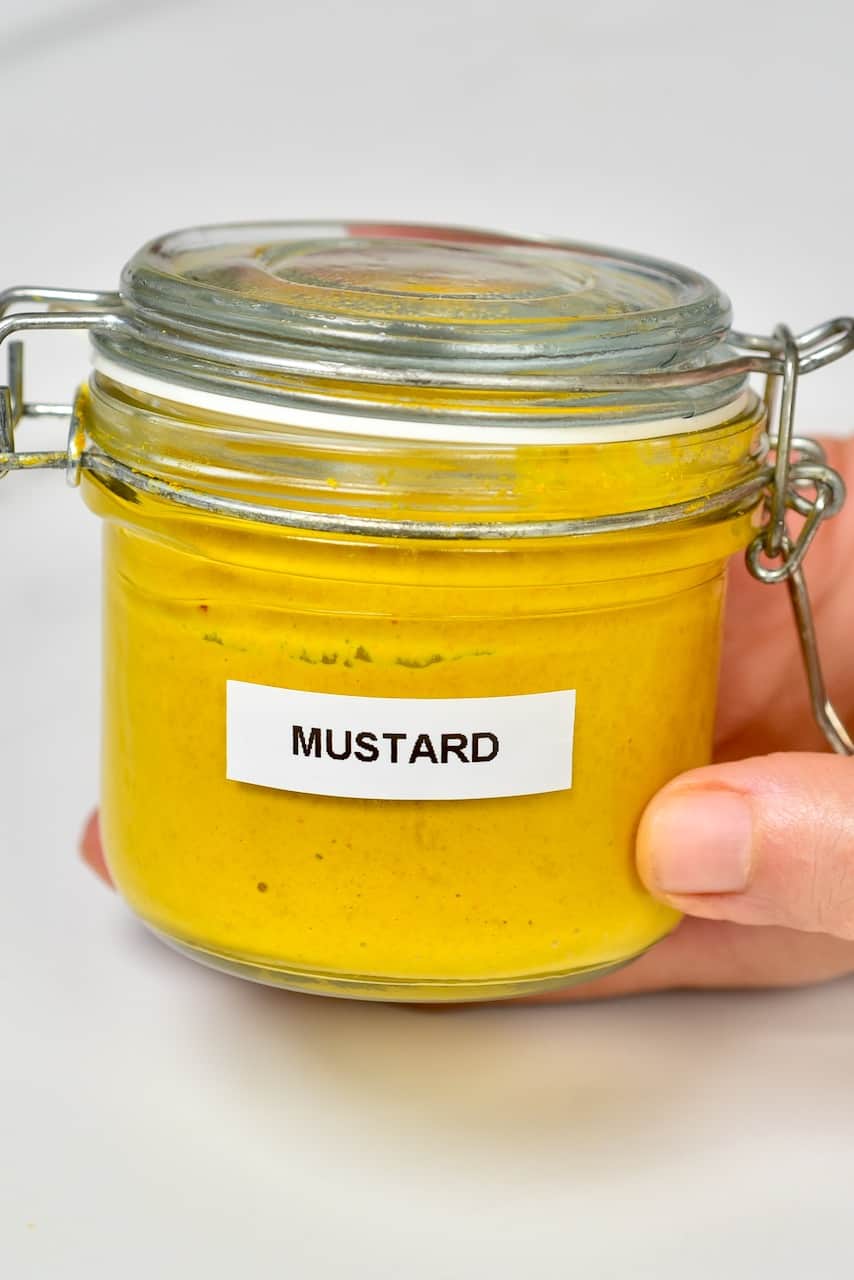
Other DIY Recipes
- How to Pasteurize Eggs (3 Ways + Bonus)
- How to Make Unrefined Cane Sugar & Jaggery (Gur)
- How to Make Miso Paste (Kome Miso/Shinshu Miso)
- How to Make Onion Powder
- How to Make Harissa Sauce (Harissa Paste)
- Simple Honey Mustard Dressing (Vinaigrette, Creamy or Vegan)
- How to Make Ginger Paste
- How to Make Flaky Salt (Plain and Infused)
If you try this mustard recipe, I’d love to hear your thoughts/questions below. Also, I’d appreciate a recipe card rating below, and feel free to tag me in your recipe recreations on Instagram @Alphafoodie!
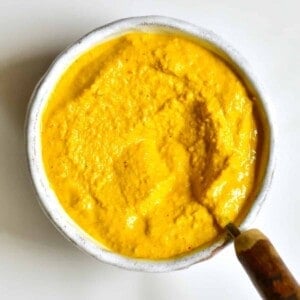
Simple Smooth Homemade Mustard
Ingredients
- 3/4 cup yellow mustard seeds
- 1.5 cups filtered water
- 1/4 cup apple cider vinegar or distilled wine vinegar
- 1/2 tsp salt
- 1/4 tsp ground turmeric powder
- 1/4 tsp red paprika
- 1/8 tsp garlic powder
- 1/8 tsp onion powder
- 1/9 tsp ground cinnamon powder
- 1 tBsp honey
Instructions
- Begin by sterilising all of your tools in boiling water and try to avoid using aluminium (aluminum) or copper utensils/pots during this mustard DIY, as it can affect the taste of your final product. Stick to glass, ceramic and wood.
- Powder the seeds in a spice grinder or a food processor (if it has a small jar). You could also use a mortar and pestle, but it will take a while, and a bit of an arm workout, to achieve the powdery consistency you like.
- The finer the powder, the smoother the mustard will be. If you prefer it a little more chunky, then don’t blend to a fine powder.
- Mix the mustard powder with the rest of the spices.
- In a saucepan, add the water and the spice mix. Keep the vinegar aside for now.
- Cook over low heat for about 45 minutes, until it starts bubbling.
- Add the vinegar and let it bubble for another 5-10 minutes. Stir occasionally as it can stick to the bottom of the pan slightly.
- Pour in a glass container and leave to cool down completely before transferring to the refrigerator.
- Store in an airtight jar and leave alone for at least 24 hours in the fridge. Mustard is at it’s most bitter when it has just been made and requires 24 hours (at-least) to mellow out, sometimes slightly longer.
- Store this in the refrigerator for around three months.
Video
Notes
- With this recipe, I do a long slow cook, as I’m preparing milder mustard. However, for a ‘hot’ (as in spicy) version then it’s best to use cold liquids. Whereas, for a milder, mellow yellow mustard, then you can use warmer liquids.
- As a general rule, lighter seeds mean a milder taste and darker seeds mean a hotter, more bitter flavour.
- As this mustard recipe uses ground seeds, it goes without saying that the amount of time spent grinding the seeds will affect the texture of your mustard recipe. If you want a thicker texture, then leave the seeds slightly coarser, for super-smooth, then blend them into as fine of a powder as you can manage.
- Vinegar is used in the recipe to preserve the mustards ‘zing’ – Without this acid, it would mellow and lose it’s tang quickly.
- It’s important to note that your homemade mustard will be at it’s most bitter for the first 24 hours after making it. However, the bitterness will fade over time. It’s good to store it in the refrigerator for a day or so while waiting for it to mellow slightly.
- Adding salt to the recipe is what helps preserve the mustard (along with the vinegar). My jar is usually finished within about a month and a half, but I think this would be fine to store for three months, in an airtight container in the fridge – If not, even longer.
- To turn this recipe into homemade honey mustard, then you need to add more honey. Lots of recipes call for a 1:1 ratio of honey to mustard. However, I think you can use less than this, to begin with. In fact, you can make it in a smaller batch by preparing this mustard DIY and then when you want the sweeter version, mix in a tablespoon of honey at a time until you reach your desired sweetness
Nutrition
Nutrition information is automatically calculated, so should only be used as an approximation.

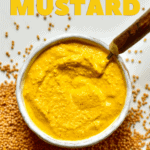









Question: can lemon juice be used instead of vinegar?
Hi Debi,
I recommend using vinegar—you can use apple cider vinegar, white wine vinegar, or even sherry vinegar. You could give lemon juice a try, but the taste would change. Let me know how it goes!
Could you tell us how much this makes. A cup, 2 pint?
Hi Serena,
This yields about 1 cup.
Love it!
Glad you liked it, Julie 🙂
Hi there, looks like a great recipe. Did you perhaps mean 45 seconds for the cooking of the mustard? or is it really 45 minutes? thank you, love your recipes
Hi Diana,
It takes 45 minutes over low hear. It needs to reduce a bit and start bubbling. I hope this helps.
Hi
could this be pressure canned to increase shelf life please?
Hi Nicole,
You should be able to water bath can this recipe. I haven’t tried canning it yet, so I can’t recommend how long. It’s best to check with official Food Preservation Guides.
What’s the difference between making a mustard that’s cooked versus uncooked? Does cooking it result in a milder flavor?
Hi Jim,
Yes, cooking it gives it more of a mellow flavor while still maintaining the classic mustard “zing”.
How much mustard powder will 3/4 cut mustard seed make? I already have some mustard power ground
Hi Kathy,
You can use 3/4 cup mustard powder. I hope this helps.
Hola, me ha ido muy mal las veces que intenté hacer mostaza, siempre terminaba con un intenso sabor a plástico y acababan en la basura… solía comprar granos de dijon y siempre las hice en frío, voy a probar esta receta en caliente porque me encanta hacer cosas caseras espero que esta vez me salga rica…
Thanks for your comment, Lili. I hope this recipe works for you 🙂
Wow! I have been searching for homemade mustard recipes and even made a few, which yielded mixed results. This recipe, however, is amazing! Complex, tasty, a slight bit sweet but only balances the heat of mustard, and it is not too hot either! The only thing I changed is the honey – I used maple syrup because it is a low glycemic sweetener (my husband is diabetic). Thank you soooo much for posting!
From my experience, soaking the seeds seems to make a HUGE difference in the outcome of the finished product.
Thank you so much for your comment and tips, Pam. Glad you enjoyed the recipe!